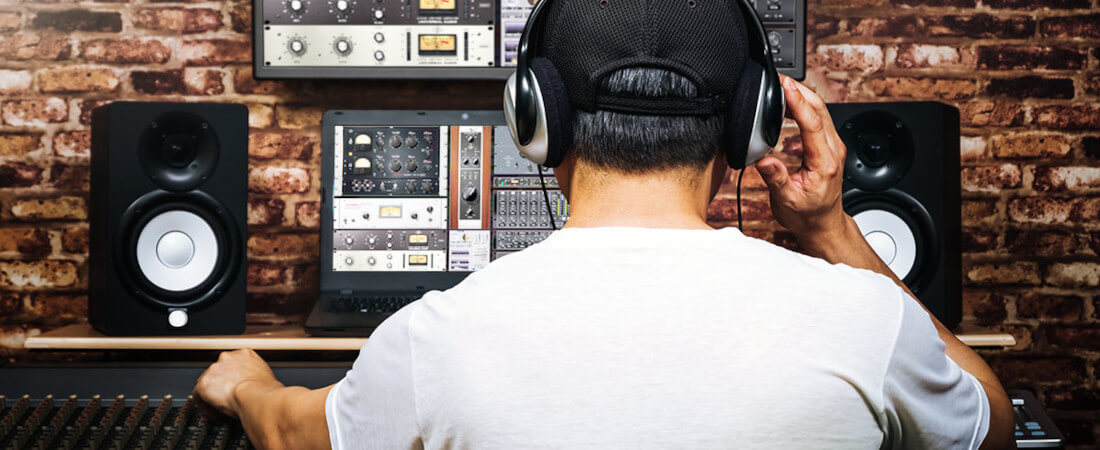MIXING IN STUDIO
The process of mixing in the studio when making songs involves several key steps. Firstly, the individual tracks recorded during the production phase are imported into a Digital Audio Workstation (DAW) software. The mixer then organizes and labels the tracks, setting up the session for mixing.
Next, the mixer focuses on achieving a balanced and cohesive sound by adjusting the volume levels and panning of each track. EQ (equalization) is applied to shape the frequency response of individual instruments and vocals, while compression is used to control the dynamic range and ensure a consistent sound throughout the song. Additional effects such as reverb, delay, and modulation are applied to add depth, ambiance, and creative elements to the mix.
Automation plays a crucial role in creating movement and dynamics within the mix. The mixer utilizes automation to adjust parameters over time, such as volume, panning, and effects, to enhance the musicality and emotion of the song. Fine-tuning and critical listening are performed to ensure the mix translates well on different playback systems.
Mixing in professional studio benefits
Mixing or producing music in a professional studio offers several advantages compared to mixing at home. Firstly, professional studios are equipped with high-quality monitoring systems, including studio monitors and acoustic treatment, ensuring accurate and reliable sound reproduction. This allows the mixer to make precise decisions regarding levels, EQ, and spatial placement of elements within the mix.
Secondly, professional studios often have a dedicated acoustically treated control room, providing an optimal listening environment. This controlled acoustic environment minimizes room-related artifacts, such as unwanted resonances and reflections, allowing for more accurate monitoring and critical listening.
Thirdly, professional studios are typically equipped with a wide array of outboard gear, including high-end compressors, EQs, and effects processors. These tools offer a greater range of sonic possibilities and allow for more detailed shaping and sculpting of the mix.
Moreover, professional studios often have experienced engineers who specialize in mixing and have a deep understanding of audio processing techniques. Their expertise and trained ears can contribute to achieving a polished and industry-standard mix.
Additionally, the professional studio environment allows for collaboration and feedback from producers, artists, and other professionals involved in the project. This input can lead to better decision-making and creative enhancements to the mix.
Lastly, professional studios provide a focused and dedicated space for mixing, free from distractions and limitations commonly found in home environments. This allows the mixer to solely focus on the task at hand, resulting in increased efficiency and attention to detail.
While home studios have made significant advancements, professional studios still offer a higher level of precision, technical resources, expertise, and sonic accuracy, making them a preferred choice for critical and professional-grade music mixing.
Mixing in studio preparations
Before taking your project to a professional studio for mixing, it is essential to adequately prepare your demo and audio channels. Here are some typical steps to consider:
-
Consolidate and organize your project: Ensure that all audio files used in your project are properly consolidated, meaning they are copied or exported to a single folder or location. This helps avoid missing or disconnected files and simplifies the transfer process to the professional studio.
-
Clean up and edit your tracks: Take the time to clean up any unwanted noises, clicks, pops, or recording errors in your individual audio tracks. Trim the regions and make any necessary edits to remove any unnecessary or problematic sections.
-
Label and organize your tracks: Assign clear and descriptive names to each track to help the mixer easily identify and navigate through the session. Group related tracks together, such as drums, guitars, vocals, etc., to maintain an organized and logical arrangement.
-
Ensure consistent levels: Make sure that the levels of your individual tracks are relatively balanced before sending them for mixing. Avoid excessive clipping or distortion and ensure that none of the tracks are too quiet or too loud compared to others.
-
Disable unnecessary processing: Remove any plugins or effects that were used for monitoring purposes during the recording or demoing stage. It’s best to provide the raw, unprocessed tracks to the mixer, allowing them to apply their own processing and make appropriate decisions for the final mix.
-
Provide reference tracks or notes: If you have specific ideas or references for how you envision the final mix to sound, it can be helpful to provide reference tracks or detailed notes to the mixer. This helps communicate your desired tonal balance, dynamics, and overall sonic direction for the mix.
By preparing your demo and audio channels in this manner, you provide a clean and organized starting point for the mixer in the professional studio. This allows them to focus on the creative aspects of the mix and make informed decisions without any technical hindrances or distractions.
Frequently asked questions
Q: In what format should I bring my songs when mixing in a studio?
A: When bringing your music for mixing in a professional studio, it is generally recommended to provide your audio files in a high-quality, lossless format. The most commonly used audio formats for professional mixing are:
- WAV (Waveform Audio File Format): WAV files are widely accepted and offer uncompressed audio with excellent quality. They preserve the full fidelity of the original recordings and provide the mixer with the highest level of flexibility for processing and editing.
- AIFF (Audio Interchange File Format): AIFF files are similar to WAV in terms of audio quality and lossless compression. They are commonly used on Mac systems and are compatible with most professional audio software and hardware.
- FLAC (Free Lossless Audio Codec): FLAC is a popular lossless audio format that offers high-quality compression. It reduces file size without sacrificing audio quality, making it a suitable choice for transferring large projects while preserving fidelity.
- ALAC (Apple Lossless Audio Codec): ALAC is Apple’s equivalent to FLAC, offering lossless compression for audio files. It is commonly used within Apple’s ecosystem and is compatible with various software and devices.
Q: Do I need to know anything about music mixing if I use studio mixing services?
A: No, you don’t need to have extensive knowledge about music mixing if you’re using studio mixing services. One of the benefits of working with professional mixing engineers is that they possess the technical expertise and experience to handle the intricacies of the mixing process.
However, it can still be beneficial to have a general understanding of mixing concepts and terminology. This allows for effective communication with the mixing engineer and ensures that your creative vision is effectively translated into the final mix. Being familiar with basic terms such as EQ, compression, panning, and effects can help you provide clearer instructions and feedback to the engineer.
Blog Articles
Mixing In Key Or Harmornic Mixing
Mixing in key refers to the practice of aligning the musical elements in a mix to ensure they are harmonically compatible. It involves considering the key or musical...
Using a reference track to improve your mixes
» Setting a benchmark » Developing a better ear » Improving your techniques » Avoid common mistakes Mixing is a complex process that involves balancing the different...
Using a limiter or clipper in music mixing and production
WHEN AND HOW TO USE A LIMITER MIXING MUSICAudio mixing and production involve a range of techniques and tools to shape the sound of a track. One essential tool in this...
Extras
Blog
Other News
Contact Page
About Us



